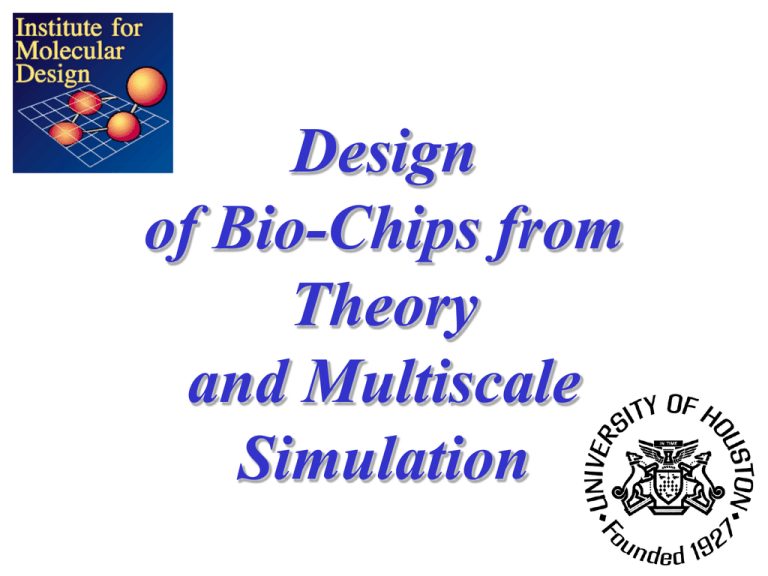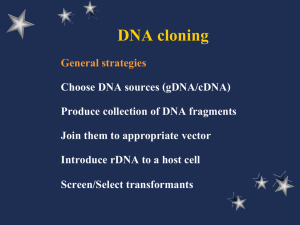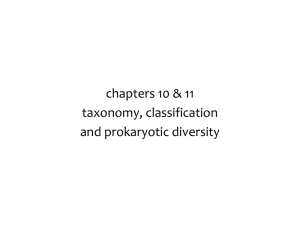View
advertisement

Design of Bio-Chips from Theory and Multiscale Simulation Prominent Technologies DNA and Peptide/protein DNA & Protein Microarrays are useful for a variety of tasks • Genetic analysis • Disease detection • Synthetic Biology • Computing What tools are required? • $1000 Genome at birth • $100 Diagnostic exam • Proteome at birth? • Universal standards Problems in Surface Mounted technologies: Microarrays, Next-gen … Cross platform comparisons • Controls • Validation • Data bases for comparisons Nearly impossible due differences in the physics and chemistry at the surface A Central Theoretical Issue: Binding (recognition) is different in the presence of a surface than in homogeneous solution. The surface determines: Polarization fields Ionic screening layers Ultimately: Device response Salt Water TG A C C G G G -T C A TA 5nm - - - -- --- -GC -TAAT - CG -GC AT Targets - - - -- Prepared Hard Surface Probes Materials, Preparation and Size Matter • DNA prep 10nm 100nm 10 μm to bulk solid What length scales are required? • Solid Substrate Roughness • Linkers • Surface Probes • Targets • Solution Correlations Chemistry Na Cl .1 to .8 M Probe Target Simulations and Theories of Bio Chips Set up must include • • • • • • • Substrate (Au, Si, SiO2 …) Electrostatic fields Surface modifications Spacers (organic) Probe and Target Bio (DNA or peptide) strands Salt and lots of Water Wong & Pettitt CPL 326, 193 (2000) Wong & Pettitt TCA 106, 233 (2001) Force field, … Wong & Pettitt Biopoly 73, 570 (2004) Pettitt, Vainrub, Wong NATO ASI (2005) Qamhieh, Wong Lynch Pettitt IJNAM (2009) Simulate a simple classical force field Model the interactions between atoms • Bonds - 2 body term – harmonic, Hooke's law spring 2 K ( r r ) b e bonds • Angles - 3 body term 2 K ( ) e angles • Dihedrals - 4 body term K 1 cos(n ) torsions Source: http://www.ch.embnet.org/MD_tutorial/ Nonbonded Terms • 2 body terms • van der Waals (short range) & Coulomb (long range) Nonbonded pairs of atoms ij 12 ij 6 qi q j 4 ij r r r • Coulomb interaction consumes > 90% computing time Ewald Sum electrostatics to mimic condensed phase screening • Periodic Boundary Conditions Electrostatic Forces Dominate Behavior F = ma or V (r ) mr With a classical Molecular Mechanics potential, V(r) These potentials have only numerical solutions. r (t t) r (t ) r(t )t r(t )t 0(t ) 1 2! t must be small, 10-15s 2 3 Correlations • Neither Vertical nor Flat on surface (tilt) • Nonuniform Structures • Linker/spacer effects Wong & Pettitt CPL 326, 193 (2000) Wong & Pettitt TCA 106, 233 (2001) Implications • Colloidal behavior affects – synthesis / fabrication – and binding • Tilt restricts possible geometries of pairing • Affinity and specificity G & G Forces: Surface and Solution –– –– –– –– – – – – – – – – – – – – – – – – –– –– – – – – – – – – Water +[salt] ± ± ± ± ± Substrate Theory Calculate the free energy difference of hybridization between that in solution and on a surface Target + Probe Gsol-hybrid Target : Probe Gdup-attach Gss-attach Gsur-hybrid Target + Probe:Surface Target :Probe:Surface Gsol-hybrid -Gsur-hybrid= Gss-att-Gdup-att Theory To get the work to form a single duplex on the surface we need: • ΔGsol which we can take from thermodynamic tables: solution reference state (John SantaLucia). • ΔGatt from a consideration of the surface effects (chemistry and physics) Coarse graining DNA electrostatic field (Poisson-Boltzmann) J. Ambia-Garrido Vainrub, Pettitt, Chem. Phys. Lett. 323 160 (2000) Ambia-Garrido, Pettitt, Comp Phys Com 3, 1117 (2008) The ions and water penetrate the grooves. Na+ Cl- H2O Feig & Pettitt BJ 77, 1769 (1999) A Simple Model • Ion permeable, 20 Å sphere over a plane/surface – 8 bp in aqueous saline solution over a surface • Linear Poisson-Boltzmann has an analytic solution h DNA - Vainrub and Pettitt, CPL ’00 Ellipse - Garrido and Pettitt, CPC, 08 The shift of the dissociation free energy or temperature for an immobilized 8 base pair oligonucleotide duplex at 0.01M NaCl as a function of the distance from a charged dielectric surface q=0 or 0.36e-/nm2 Tm H S linker Vainrub and Pettitt, CPL ’00 Vainrub and Pettitt, Biopoly ’03 Surface at a constant potential for a metal coated substrate @ .01 M NaCl Vainrub and Pettitt, CPL ’00 Vainrub and Pettitt, Biopoly ’03 Response to E-fields Salt and Substrate Material Effects on 8-bp DNA 0.001M 0.01M 0.1M 1M o Shift of melting temperature T ( C) 0 -50 DIELECTRIC =0 -100 0.1 1 10 DIELECTRIC = -25 mV 0.1 1 10 DIELECTRIC = +25 mV 0.1 1 10 200 METAL =0 150 METAL = -25 mV METAL = +25 mV 100 50 0 0.1 1 10 Vainrub & Pettitt, Biopoly 2004 0.1 1 10 Distance from surface h (nm) 0.1 1 10 Finite Concentration and Coverage 2 k2 outside the sphere and plane, 2 k2 r/0 inside the sphere, |r =a+ = |r =a- , r |r =a+ = r |r =aon the sphere, |z =0+ = |r =0- , z |z =0+ - r |z =0- = -/0 on the plane. Different from O & K h Vainrub and Pettitt, Biopolymers 2003 Vainrub & Pettitt et al , NATO Sci , 2005 Coulomb Blockage Dominates Optimum DNA spacing High negative charge density repels target surface binding Langmuir On Chip Target Conc θ H 0 TS0 wn P Z P ( Z P ZT exp C0 exp RT 1 θ RT Probe surface density hybridization efficiency θ (0 θ 1) target concentration C0 Vainrub &Pettitt, PRE (2002) Vainrub &Pettitt, JACS (2003) Experimental Isotherm for perfectly matched lengths -11 ln[(1-)C/] -12 -13 -14 -15 0 5x10 12 1x10 13 2x10 13 (1+)Np Explains some experiments: • Low on-array hybridization efficiency on glass (Guo et al 1994, Shchepinov et al 1995) • Broadening and down-temperature shift of melting curve (Forman et al 1998, Lu et al 2002) • Surface probe density effects (Peterson et al 2001, Steel et al 1998, Watterson 2000) Melting curve temperature and width Analytic wrt surface probe density (coverage) W + W In solution Tm = H0/ S0 – R ln C) 1.0 4RTm2/H0 On-array: Isotherms Tm 3wZ2 n p 2H 0 3wZ n p 2 W Tm 3 12 10 8 0.8 2 Hybridization efficiency W= W 6 4 210 *1012 nP probes/cm2 0.6 0.4 dA20 /dT20 duplex 0.2 Parameter: [(Vd-Vp)/RT0]*qp*Np 0.0 200 250 350 Temperature (K) Tm - Tm Critical for SNP detection design 300 Tm Pettitt et al NATO Sci 206, 381 (2005) Strength and linearity of hybridization signal 12 2 Hybrids density (1/cm ) 10 1 10 10 2 4 6 8 0.1 x1012 11 2x10 10 10 0 0 10 9 5x10 12 1x10 13 2 Probe density (1/cm ) 10 -2 10 -1 10 0 10 1 2 10 10 3 10 4 Target concentration (*exp[G0/RT0] Moles) Vainrub and Pettitt JACS (2003); ibid Biopolymers, (2004) Peak of sensitivity RT np 2 wZ P Normalized hybridization signal 1.0 T = 330 K 0.8 T = 332 K 0.6 T = 334 K 0.4 T = 340 K 0.2 T = 360 K 0.0 0.0 12 2.0x10 12 4.0x10 -2 Probe surface density (cm ) Vainrub and Pettitt, JACS (2003) Linear range of hybridization 0 10 Non-linear error is below 1 2 wn Z Z θ (1 θ ) RT wn Z Z θ δ P P T 2 exp P P T 1 RT (1 θ ) RT H 0 TS 0 wn P Z P2 exp RT Hybridization efficiency 3 10 1 2 3 4 -1 4 10 -2 10 -3 1 2 3 4 12 10 3 4 -4 -13 10 -11 10 -9 1x10 -7 1x10 -5 1x10 Target concentration (mol/L) Beyond the linear range use the on-array binding isotherm n P S C0 N V A θ H 0 TS 0 wn P Z P ( Z P Z T exp exp 1 θ RT RT -3 1x10 Probe vs. Target lengths often mismatch in various ways ... vs. Longer sequences are the expected and require true mesoscale models Perfect pairing Garrido Vainrub &Pettitt CPC ‘10 Pairing w/ an overhang To Accommodate Longer Sequences and Secondary Structure Near a Surface Mesoscale: Allow for variations in Linker chemistry Over-hang Under-hang on probes and targets in all combinations. Parameterize ssDNA as well as dsDNA. Garrido Vainrub &Pettitt JPCM submitted DNA Entropic contributions • • • • Sample with Monte-Carlo via Meirovitch (hypothetical scan) via Quasi Harmonic Correlations of sequence mismatch with physical corrections • Data mining for equilibrium thermodynamics ΔG ΔG Information vs efficiency • ssDNA has the same spatial average as dsDNA but not fluctuations. • Longer strands have more information 4n. – Kinetic problem • Shorter strands pair more efficiently. – Kinetic balance High Salt is Far Beyond Analytic PB (Mean Field) Electrostatics Gouy-Chapman ~1910 Double layer at charged interfaces. How good is this? Add all the atoms via integral equations in 3D (renorm.- HNC) Solvent and ion charge densities MF-PB H2 O w/ Ions ε=80 HNC-IE Charge-Charge correlations • • • • Multi Layer effects not Bilayer Dominate at interfaces Determine the thermodynamics Change the kinetics To design for Affinity and Specificity Coverage and Surface effects • Use Electric fields – Effects of DNA with poly cations • Use surface effects – Layered hard materials • Use quantitative theories – Explicit polymer entropy – Non m.f. coverage and electrostatics Arnold Vainrub Clem Wong Joaquin Ambia-Garrido Jesse Howard Khawla Qamhieh Alex Micu Keck Center for Computational Biology Mike Hogan, Lian Gao, Rosina Georgiadis, Yuri Fofanov Thanks to NIH, NASA, DOE, Welch Foundation, ARP &SDSC, PNNL, PSC, NCI, MSI







